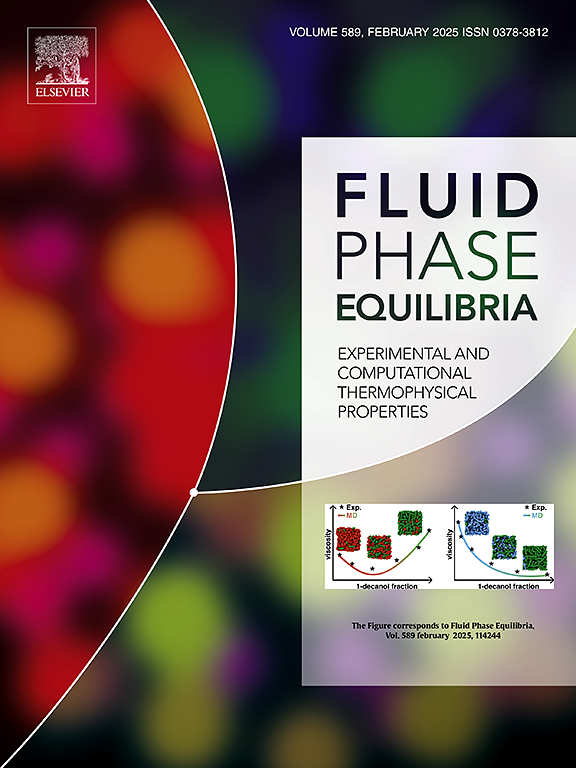用PC-SAFT模型表示了81个由烷烃-1-醇甲酯组成的二元化合物的混合性质
IF 2.7
3区 工程技术
Q3 CHEMISTRY, PHYSICAL
引用次数: 0
摘要
PC-SAFT作为一种拟合和预测方法,用于模拟81种由烷酸甲酯和1-烷醇组成的二元混合物在常压和298.15 K下的过量摩尔性质;其实验及相关数据来源于文献。此外,我们还将PC-SAFT获得的9种二元烷酸甲酯(乙醇酸到丁酸)+ 1-烷醇(乙醇到1-丁醇)混合物的VLE与文献中发表的101.32 kPa的实验数据进行了比较。对二元相互作用参数kij进行了调整,以校正伦敦色散力,并使用过量摩尔体积和过量摩尔焓数据进行拟合。通过计算,我们得到了PC-SAFT和文献数据在质性上很好的一致性,这些二元混合物在混合过程中表现出主要的排斥力和吸热效应。最后,发现PC-SAFT正确地预测了所分析的9种二元混合物的VLE(不使用可调参数)。在过量摩尔焓的情况下,戊酸甲酯+ 1-烷醇组的结果最符合(18.11%),而在过量摩尔焓的情况下,戊酸甲酯+ 1-烷醇组的结果最符合(7.04%)。另一方面,PC-SAFT能够从预测和定量的角度正确表征9种二元混合物的液气平衡实验数据,其沸点和气相摩尔分数的偏差分别为0.31%和2.29%。本文章由计算机程序翻译,如有差异,请以英文原文为准。
Using the PC-SAFT model to represent the mixing properties of 81 binaries formed by a methyl alkanoate with an alkan-1-ol
PC-SAFT has been used as a fitted and predictive approaches for modeling the excess molar properties of 81 binary mixtures composed of methyl alkanoate and 1-alkanol at atmospheric pressure and 298.15 K; whose experimental and correlation data were obtained from the literature. Furthermore, we have compared the VLE obtained with PC-SAFT for 9 binary mixtures of methyl alkanoate (ethanoate to butanoate) + 1-alkanol (ethanol to 1-butanol) with experimental data published in the literature at 101.32 kPa. The binary interaction parameter, known as , was adjusted to correct for London dispersion forces, and excess molar volume and excess molar enthalpy data were used for the fitting. From the calculations, we have obtained a good qualitative agreement between PC-SAFT and literature data for most binary mixtures, which present predominant repulsive forces and an endothermic effect in the mixing process. Finally, it was found that PC-SAFT correctly predicts (without using adjustable parameters) the VLE of the 9 binary mixtures analyzed. The best agreement in the representation of the experimental data of excess molar volume was obtained for the group of mixtures of methyl ethanoate + 1-alkanol (18.11%), while in the case of excess molar enthalpy, the best results were obtained for methyl pentadecanoate + 1-alkanol (7.04%). On the other hand, PC-SAFT was able to correctly represent the experimental data of liquid–vapor equilibrium for 9 binary mixtures from a predictive and quantitative perspective and deviations in boiling point and mole fraction in vapor phase of 0.31% and 2.29% were obtained, respectively.
求助全文
通过发布文献求助,成功后即可免费获取论文全文。
去求助
来源期刊

Fluid Phase Equilibria
工程技术-工程:化工
CiteScore
5.30
自引率
15.40%
发文量
223
审稿时长
53 days
期刊介绍:
Fluid Phase Equilibria publishes high-quality papers dealing with experimental, theoretical, and applied research related to equilibrium and transport properties of fluids, solids, and interfaces. Subjects of interest include physical/phase and chemical equilibria; equilibrium and nonequilibrium thermophysical properties; fundamental thermodynamic relations; and stability. The systems central to the journal include pure substances and mixtures of organic and inorganic materials, including polymers, biochemicals, and surfactants with sufficient characterization of composition and purity for the results to be reproduced. Alloys are of interest only when thermodynamic studies are included, purely material studies will not be considered. In all cases, authors are expected to provide physical or chemical interpretations of the results.
Experimental research can include measurements under all conditions of temperature, pressure, and composition, including critical and supercritical. Measurements are to be associated with systems and conditions of fundamental or applied interest, and may not be only a collection of routine data, such as physical property or solubility measurements at limited pressures and temperatures close to ambient, or surfactant studies focussed strictly on micellisation or micelle structure. Papers reporting common data must be accompanied by new physical insights and/or contemporary or new theory or techniques.
 求助内容:
求助内容: 应助结果提醒方式:
应助结果提醒方式:


